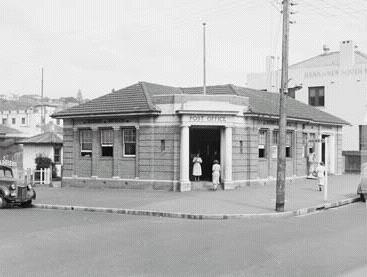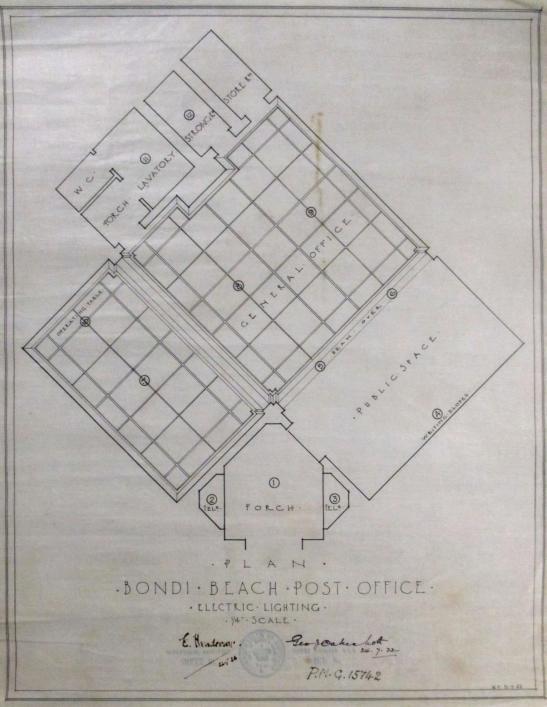Edwin Hubert Henderson Architect
This site is dedicated to the life and work of Edwin Hubert Henderson, architect (1885-1939). Henderson was Chief Architect of the Commonwealth of Australia from 1929-1939.
Bondi Beach Post Office and Henderson

Bondi Beach and surfing have a strong resonance in Australian culture. While in colonial times public bathing was actually illegal, by the turn of the century the public love of the surf had overcome Victorian prudery and the first life saving clubs were established.
Bondi was a fast growing area, particularly in the inter-war period. As tourists and holiday makers flocked to the area, and new development occurred, demand increased for a new postal service to cope with demand. Land had been purchased as early as 1914, and in 1921 the local MP met with the postal inspector and the Bondi Progress Association to discuss the need for a new service to supplement the two licensed stamp sellers and couple of post boxes in the area. In March 1922, thanks to the lobbying of local MP and Federal Treasurer, Sir Joseph Cook, the Government committed £ 3,000 to the project.
The Bondi Vigilante Association demanded that the post office be called “Bondi Beach” rather than “North Bondi” which was preferred by the Post Master General’s department. The vigilantes won and on 12 October 1922 the new post office name was officially designated.
Henderson was the man to design this post office.
Design
The post office building was constructed on the corner of Hall Street and Jacques Avenue.
The design is a compact, single storied, brick building with a columned corner entry. The entry has a pair of Tuscan order columns and entablature (architrave, cement rendered frieze and cornice) with “Post Office” inscribed on the frieze. The front door is flanked by flat, rendered pilasters. The street facades have brick pilasters with cement rendered capitals and plinths which flank three sash windows. A brick plinth surrounds the façade. The roof is of terracotta shingle.

The 1922 specifications contain some interesting reminders of the imperatives of Australia in the period including:
“preference shall be given – other things being equal – firstly to Returned Sailors and Soldiers with satisfactory records of service, and secondly to members of Trades Unions”
Building materials were to be:
“Australian…and if Australian materials are not available, British materials…wherever possible; in the event of Australian and British materials not being available, then preference should be given to materials of Allied countries”.
The post office had wooden phone cabinets, as the Post Master General’s Department handled both post and telegraph and telephone.

When opened it had 15 staff, who started work early (about 6.15am) sorting the mail, with the official opening being 9am.

The Post Office was extended to 1934 in a sympathetic style by architects H Sturtevant and C Todd by the Department of Works. Henderson would have been Principal Designing Architect by this time.
Style
The Post Master General’s Department preferred its post offices to be of a “superior design” reflecting the “recognition of the social importance of public buildings”. This requirement perfectly reflected Henderson’s style and the prevailing approach of government architects across Australia.
The Australian Heritage database describes the Bondi Post Office in this way:
The post office and telegraph office (possibly originally with residential quarters) was designed by E H Henderson under George Oakeshott’s aegis as State head of the Commonwealth Public Works Office, in the Colonial Georgian Revival Style.
Stylistically and architecturally…Bondi Beach is significant as one of a small group of compact, domestically scaled brick post offices in New South Wales designed by Henderson. It is reflects and develops several design signatures worked out by architects Murdoch and Mackennal in other states”.
Other post offices designed by Henderson in a similar fashion include Albury and Goulburn. The Haymarket Post Office is another of the collaborations between Henderson and Oakeshott.
The Colonial Georgian Revival Style emerged in the 1910s, popularised by the work of William Hardy Wilson, a Sydney architect who admired American colonial architecture and the early architecture of New South Wales starting with Francis Greenaway under Governor Lachlan Macquarie. This was the first time that architects looked back to an earlier style of our own architecture as inspiration. Hardy published his book “Old Colonial Architecture in New South Wales and Tasmania” in 1923. This trend echoed directions embraced in the UK by architects like Sir Edward Lutyens and by McKim, Mead and White in the US.
George Oakeshott (1862-1924) was NSW Works Director from 1902 until his death in 1924. He designed a number of post offices and other buildings such as the Millers Point Drill Hall, the Small Arms Factory at Lithgow and the North Head Quarantine Station. He worked with John Sulman on a housing scheme for workers in Lithgow that served as a model for housing in Canberra. He was also a member of the board overseeing the design of Canberra during 1912 and designed the Australian Pavilion for the 1915 Panama Pacific International Exhibition. Oakeshott was born in Hackney in London and was the great grandfather of independent MP, Rob Oakeshott.
Other similar style of post offices were constructed under Oakeshott’s direction such as Maroubra, Charing Cross and Mascot Airport. James Orwin, Henderson’s friend, was Oakeshott’s successor as Works Director in NSW.
Preservation
Fortunately, the Post Office is heritage listed by the Australian Government and the Waverley Council. It is not state listed.

References
Apperly, Irving and Reynolds. 1989. A Pictorial Guide to Identifying Australian Architecture.
Brady, A. 2017. Bondi Beach Post Office Heritage Management Plan. Australia Post.
Goad and Willis. 2012. The Encyclopedia of Australian Architecture.
Sydney Morning Herald “Who do they think they are” 26 December 2010.
